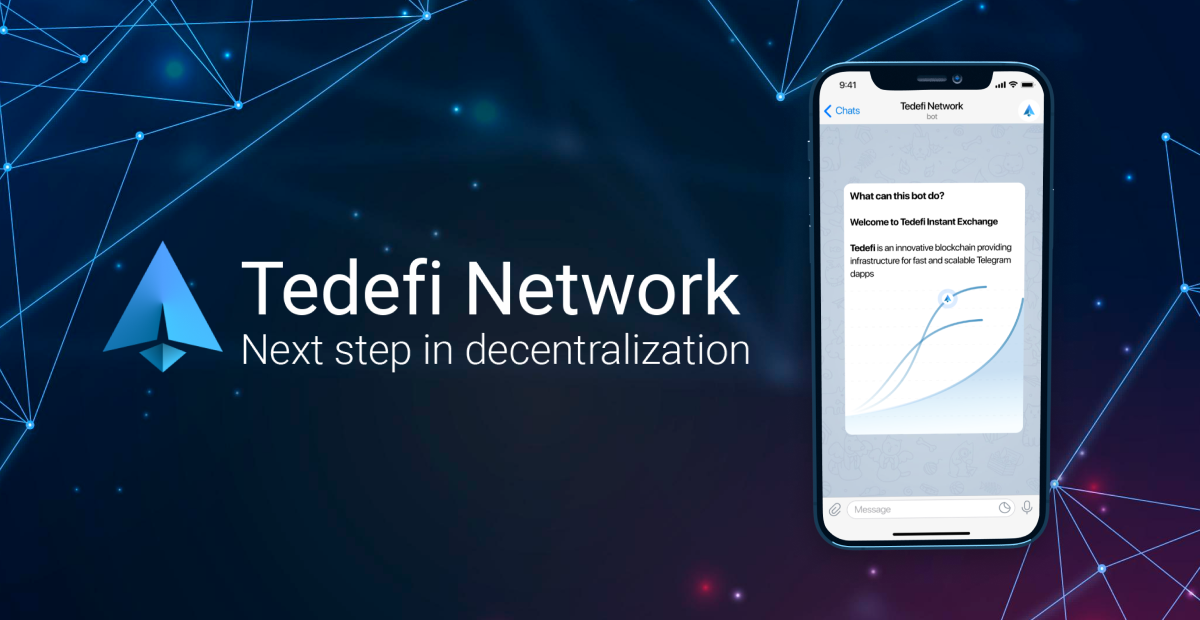Blockchain innovation to facilitate DApp delivery on Telegram
TeDeFi is the new scalable blockchain solution that integrates with Telegram and enables developers to create decentralized applications in the social network and cryptocurrency users to transact cryptocurrencies from their Telegram accounts. The TeDeFi blockchain protocol solves the problem of centralization and interferences that is common in the crypto market today.
The TeDeFi solution
As the crypto market continues to expand, the goal of decentralization that blockchain technology represents eludes most blockchain projects. Most of the prominent players in the crypto market are centralized corporations that are managed and structured like normal businesses.
Due to the influence of these companies, crypto users have to deal with bottlenecks like transaction limits, wallet creation and custody of passphrases, not to mention the fact that if a passphrase is lost, the wallet and the money it contains can also be lost. To interact with a decentralized exchange one would need a wallet application or extension, most of which are owned by centralized institutions, defeating the purpose of blockchain creation.
TeDeFi offers something new to crypto enthusiasts who crave actual control over their assets and governance skills over blockchain networks. By integrating with Telegram and using the MTProto protocol, TeDeFi ensures users security, scalability, easy transactions and complete control over the assets.
TeDeFi was designed to model the validation consensus protocol used by the Binance Smart Chain network. A group of validators, twenty-one in number, confirms transactions and ensures optimal network expansion. Users will prove their trust in each of these validation nodes by staking, and someone else could replace any node that does not meet the requirements.
The BSC network runs on a Proof of Staked Authority model, as opposed to Bitcoin, which uses the Proof of Work model, and Ethereum, which recently switched to Proof of Stake. TeDeFi follows a similar consensus model. The validator nodes in the TeDeFi network also serve as webhooks for the API function of Telegram bots, which are integral when building dApps on Telegram.
How is TeDeFi secured?
With Telegram's MTProto protocol, TeDeFi can guarantee its users maximum financial security and information encryption. MTProto has three notable layers that support the secure distribution of messages within the network and act as the only link between the TeDeFi blockchain and Telegram.
The first layer, API Query Language, converts information from the API into binary languages that can be read by computers. These messages are then transmitted to the cryptographic layer that is responsible for the authorization. The authorization layer encrypts the messages in order to prepare them for transport through the network. The transport component helps the clients and the servers to transfer messages over existing network protocols.
It is widely considered to be near impossible to break the MTProto protocol. Thus, it is the perfect partner for TeDeFi to be successful due to its promise of maximum security for the users.
TeDeFi Telegram Exchange
The first major innovation the TeDeFi blockchain will implement on Telegram is a decentralized introduction of cryptocurrency exchanges. Users can deposit, withdraw and exchange their preferred cryptocurrencies directly from their Telegram accounts. You will also be able to trade the TeDeFi ecosystem's native token, TEFI. In the future, the Telegram exchange's TeDeFi team will add more features like the order book, advanced trading tools like limit orders and token swap options to swap one token for another.
The TeDeFi token
Like every known blockchain solution, TeDeFi has a native token, TEFI, which, among other things, is responsible for governance power. TEFI, which has a total offering of 86,800,000, will cover network transaction fees, discounts on trading fees on the TeDeFi Telegram Exchange, staking and validation bonuses.
TEFI will initially be provided in the Binance Smart Chain. The complete migration to the TeDeFi network will start in the second quarter of 2022. TEFI's sale was completed on the Telegram Exchange at $ 0.05 per token. According to the TeDeFi website, the price of the token is currently around $ 0.07.
What is in store for the TeDeFi ecosystem?
The TeDeFi team invites developers to start developing dApps with their Telegram innovation. These applications will be fully automated and provide users with a smooth experience. P2P transfers on Telegram are planned in the next updates. The TeDeFi mainnet is expected to go live in 2022.
My Top PicksHoneygain - Passive earner that pays in BTC or PayPalMandalaExchange -The Best no KYC crypto Exchange!
BetFury - Play And Earn BFG for daily Bitcoin and ETH dividends!
Pipeflare - Faucet that pays in ZCash and Matic, Games pay in DAIWomplay - Mobile dApp gaming platform that rewards in EOS and BitcoinCointiply - The #1 Crypto Earning SiteLiteCoinPay -The #1 FaucetPay earner for LitecoinUpland - Collect Digital Properties & Test Your SkillsLBRY/Odysee - YouTube Alternative that lets you earn Money by viewing videos!FaucetPay - The #1 Microwallet PlatformFREEBTC - The #1 FaucetPay earner for Satoshi'sFaucetCrypto - An earning/faucet site that pays out instantlyFireFaucet - An earning site that pays better for some than Cointiply
DogeFaucet - Dogecoin Faucet
xFaucet - BTC, ETH, LTC, Doge, Dash, Tron, DGB, BCH, BNB, ZEC, FEY - Claim every 5 minutes
Konstantinova - BTC, ETH, LTC, Doge, Dash, Tron, DGB, BCH, BNB, ZEC, USDT, FEY, 25 Claims Daily


Comments
Post a Comment